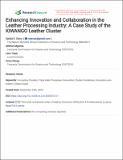| dc.description.abstract | The quest to synthesize safe, non-hazardous Ag–ZnO nanoomposites (NCs) with improved physical and chemical prop-
erties has necessitated green synthesis approaches. In this research, Launaea cornuta leaf extract was proposed for the
green synthesis of Ag–ZnO NCs, wherein the leaf extract was used as a reducing and capping agent. The antibacterial
activity of the prepared nanoomposites was investigated against Escherichia coli and Staphylococcus aureus through the
disc diffusion method. The influence of the synthesis temperature, pH, and precursor concentration on the synthesis of
the Ag–ZnO NCs and antimicrobial efficacy were investigated. The nanoparticles were characterized by ATR-FTIR, XRD,
UV–Vis, FESEM, and TEM. The FTIR results indicated the presence of secondary metabolites in Launaea cornuta which
assisted the green synthesis of the nanoparticles. The XRD results confirmed the successful synthesis of crystalline Ag–
ZnO NCs with an average particle size of 21.51 nm. The SEM and TEM images indicated the synthesized nanoparticles to
be spherical in shape. The optimum synthesis conditions for Ag–ZnO NCs were at 70 °C, pH of 7, and 8% silver. Antibac-
terial activity results show Ag–ZnO NCs to have higher microbial inhibition on E. coli than on S. aureus with the zones of
inhibition of 21 ± 1.08 and 19.67 ± 0.47 mm, respectively. Therefore, the results suggest that Launaea cornuta leaf extract
can be used for the synthesis of Ag–ZnO NCs | en_US |

